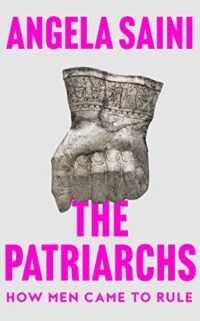Book review: The Patriarchs: How Men Came to Rule by Angela Saini
 How did men become dominant in human society? When did patriarchy begin? Was it inevitable or could the world have been different? Angela Saini looks at all the available evidence to answer these questions in her book The Patriarchs: How Men Came to Rule.
How did men become dominant in human society? When did patriarchy begin? Was it inevitable or could the world have been different? Angela Saini looks at all the available evidence to answer these questions in her book The Patriarchs: How Men Came to Rule.
Having read (and loved) her previous books Inferior and Superior, I knew I was in safe hands as I embarked on this journey to discover how human inequality began. To begin with two of the few solidly definite answers Saini can provide: no, patriarchy was not inevitable and no, it has not always been the way most human societies are structured. Reaching those answers required sifting through centuries of research, a task at which Saini excels.
Societies that are matrilineal (where family lines are tracked through the mothers) and/or matrilocal (where women stay in their childhood homes to raise their own children – sometimes with husbands going to live with them, sometimes without co-parents ever co-habiting) have existed as far back as prehistory and still exist now in pockets all over the world. Matriliny and matrilocality don’t necessarily equal matriarchy but they do lend themselves to more equal society overall, in which women can hold positions of power, own property and receive education at parity with men.
The European colonists of the 16th to 19th centuries tended to be shocked whenever they discovered indigenous communities in which all people lived equally, or where identities outside of binary gender and heterosexuality existed openly and were accepted. The very act of empire-building required that the invaders considered the indigenous people they were stealing land and resources from were inferior to them. So they would take examples like having women leaders and declare that an example of being backward. Modern societies must be patriarchal, the reasoning went.
But this wasn’t a new invention of European colonialism. State-mandated patriarchy goes back at least as far as Ancient Greece. Speaking very approximately, human society got more unequal as communities got larger and more organized – but it wasn’t a straight line. Ancient Egypt, for example, overlapped with Ancient Greece but was far less patriarchal.
The question is why? Saini can’t give a 100% definite answer to that but she does have a compelling theory.
Patriarchy isn’t about physical characteristics. Saini showed in her earlier book Inferior that the physical differences between men and women are far smaller and fewer than they appear. Much of the difference in strength, for example, comes down to men doing more physical activity throughout their lives. Even as tiny babies, boys are encouraged to move and pick up relatively heavy items such as balls and blocks, while girls are kept more still and given lighter, softer toys. Most 21st-century societies encourage men to be muscular and women to be delicate. But raised identically, the average man and average woman can do all the same physical tasks – even hunting and farming.
Backing this up, archaeological evidence shows human communities were more equal in the oldest known settlements. In Ancient Mesopotamia, men and women ate the same foods, spent the same amounts of time indoors and outdoors, had the same status when buried, and were equally revered after death.
This understanding of the evidence is relatively recent and hard-won. For decades after these ancient cities were rediscovered, archaeologists tried to understand this evidence they hadn’t expected to find. It took decades of questioning assumptions to reach our current understanding – which is affirmed by modern scientific analysis of human remains.
“Men and women are framed as opposites…never as varied individuals who might possess overlapping traits. Western goddess-worshipping myths leave little room for bloodthirsty, violent goddesses like Kali, the Hindu deity depicting slaying demons and wearing their heads around her neck…the strength of female-led societies is pinned on women having virtues that men don’t, and men having violent natures that women don’t…There’s no basis for assuming that what sound suspiciously like 19th-century beliefs about gender were held by people living in completely different societies thousands of years ago.”
So what was the main driver of patriarchy? Saini says it has always been the imperative to increase the population to support the state. As societies got larger they needed women to have more babiesto keep on increasing the size of the state, so they emphasised family, women staying at home and men going to war.
During the European Enlightenment and in the centuries that followed, a renewed emphasis was placed on Ancient Greece and Ancient Rome as those patriarchal and warlike values were used to support the new European empire expansions. Like the USA.
But like everything when it comes to humans, there is no straight line of increasing or decreasing patriarchy – it’s ever-changing in every place where patriarchy exists.
Saini does a great job of explaining all this. She’s always clear about what we know and what we aren’t sure about. I felt both angry and empowered while reading this book. I can only hope that understanding the source of inequality is a step towards removing it.
Published 2023 by HarperCollins.
Source: Storysmith Books, Bristol.
One Comments
Comments are closed.